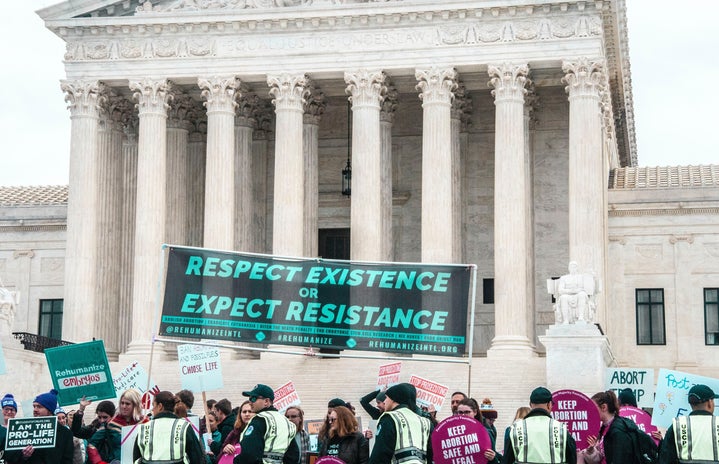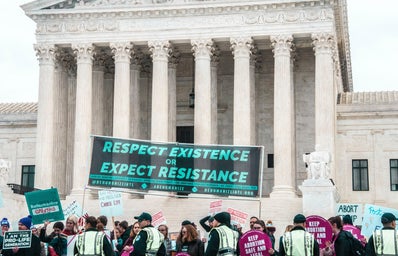The New Precedent: Dobbs v. Jackson Women’s Health Organization
On June 24, The Supreme Court of the United States (SCOTUS) sided with the state of Mississippi and overturned the 1973 Roe v. Wade ruling. With this decision, SCOTUS has decided that there is no constitutional basis for abortion, and thus nothing in the constitution prevents states from banning abortion. The court provides no limitations to abortion bans, even in cases of rape, incest or medical harm to the mother. This decision was made by a vote of 6-3, with Justices Kavanaugh, Roberts, Barrett, Gorsuch, Thomas and Alito with the majority opinion, and Justices Breyer, Sotomayor and Kagan dissenting. Following the SCOTUS decision, 13 states have already banned abortion.
Concerns of Future Damage to the 14th Amendment and Right to Privacy
Roe v. Wade was constitutionally justified under the 14th Amendment and the 4th Amendment, which guarantees all citizens equal protection and the right to privacy under the law. However with this decision, the court has stated that neither the 4th or 14th provide a constitutional basis for abortion. This decision not only has destroyed the foundation for abortion rights in the U.S. but also threatens other decisions where the 14th Amendment provides constitutional protection. These cases could include Obergefell v. Hodges, which legalizes marriage equality, Griswold v. Connecticut, which provides the right to contraceptives regardless of marital status, and Lawrence v. Texas, which concerns the right to private sexual conduct. Justice Clarence Thomas in his opinion suggests that the court review these decisions, so while abortion may not effect you directly, a threat to the right to privacy concerns all of us.
This time around, there is the added threat of cyber security being used to help prosecute those who recieve abortions where it’s banned. Hypothetically, prosecutors can now request the search history, viewing history and other pieces of data from someone’s devices to use against them in a court of law. Along these lines, data from apps used to track menstrual cycles could also be used as evidence as well.
Legal Status of Abortion After Rape
Several of the states passing abortion bans are not providing exeptions in cases of pregnancy as a result of rape or insest. Not only does this force pregnancy on victims of sexual assult, but in many states, the penalty for aborting after rape is higher than the penalty for rape. In the recent Texas abortion ban, it was proposed that those who received an illegal abortion be tried for murder. This means that if a woman is raped and becomes pregnant, her rapist would have more rights than her.
So, What Do We Do Now?
Access to Free or Low-Cost Birth Control
The first solution to banned abortion is to prevent abortions from being necessary to begin with through comprehensive sex education and expanded access to birth control. Through comprehensive sex education, especially at a young age, people are better educated about the consequences of unprotected sex. Though most contraceptives are not 100% effective, proper use significantly reduces the risk of unwanted pregnancy and therefore, abortions as well. Birth control options that are more permanent such as three-month shots or long-term intrauterine devices (IUDs) and implants are especially effective as they omit the user error that is associated with other methods of contraception. These methods are over 99% effective. When situations arise where contraceptives are not available or used, emergency contraceptives, more commonly known as the morning-after pill are another option. These pills can cost anywhere from $7-50 and can be up to 87% effective.
Unfortunately, contraceptives and birth control have costs associated with them that can make them inaccessible to people of lower-income. Abortion restrictions are particularly damaging to lower-income individuals so providing low-cost birth control is a priority. In order to receive birth control or contraceptives, an appointment with a gynecologist or other primary care physician is usually required. These appointments can be expensive without insurance, which is not universal in the United States. Secondly, the wait times to get these appointments can be months long. Additionally, workplaces often exclude birth control coverage from their insurance plans due to religious reasons. This places an additional barrier to receiving what should be readily available and stress-free care.
To combat these monetary barriers, there are options available to receive low-cost or free birth control. Regardless of whether or not they are able to provide abortions, Planned Parenthood will always offer free or low cost birth control to those who do not have insurance. If traveling to these locations provides an additional barrier, The Pill Club offers birth control that is delivered to one’s home for as low as $7 without insurance and is free with insurance. Both of these options are prescribed by a doctor following an in-person or online questionnaire to assess the best possible option for each person’s situation.
Self-Administered Abortions
Now that abortion has been banned in several states, many women may have to resort to self-administered abortions. The safest way to do this is by receiving the medical abortion pill by mail. The medical abortion pill, or Mifepristone, is taken orally and then followed up with a Misoprostol pill three days later. It is then recommended that the patient visit a primary care provider 14 days after taking the second pill to ensure that the patient is healthy. Due to the COVID-19 pandemic, the medical abortion pill was temporarily approved by the Federal Drug Administration (FDA) to be delivered by mail. Recently, this approval was permanently extended. This greatly expands the access to abortion, especially for those who are not located near a clinic. However, it is possible that this too will be banned shortly especially if it becomes a popular method of getting an abortion in states where abortion has been banned. Following the Dobbs v. Jackson Women’s Health Organization decision, Merrick Garland, the U.S. Attorney General, stated that since the FDA has approved the Mifepristone Pill to be mailed, individual states do not have the ability to ban the pill due to the supremacy clause.
Out of State Travel As a Solution
For those whose home states face abortion bans, many will be hypothetically seeking to travel to a neighboring state to receive care. By using the website ineedana.com, or “I Need an Abortion,” people can find the closest abortion clinic by putting in their age, zip code and weeks since their last period. One may also select the type of abortion they prefer, either in-office or the take-home abortion pill. While this may seem simple, there are still barriers for some to go out of state. For one, many clinics may require a consultation 24 hours before the procedure. This would require someone to take off multiple days of work and depending on the location of the procedure, pay to stay at a hotel overnight. While public transportation is an option for those without a car, it can be unreliable and expensive. There is also a possibility of legal repercussions if the home state decides to penalize those who travel out of state.
Solutions to abortion being banned in several states now that Roe v. Wade has fallen are not as much solutions, but rather attempts to control the harm that will be done. There will be unprecedented consequences that will hurt everyone involved but most severely women of color and low-income communities. Through initiatives such as increasing access to birth control, we can prevent abortions from being necessary. However, when the inevitable does occur the best option of action is to create pathways for women to receive safe abortions in states where they are legal. This solution brings about many obstacles, though when considering the health of the woman as the highest priority, this becomes the safest solution. In addition, work must also be done to break down the stigma surrounding women who have received abortions. Almost one in four women will choose to have an abortion during their lifetimes. Everyone loves someone who has chosen to have an abortion. So, why is abortion still such an uncomfortable conversation for many? The choice of whether or not to carry a child is key to one’s freedom over their own body. When legal abortion is not possible, women are forced to put their freedom over their health.
As a response to the growing threat to abortion rights, several organizations have been created to provide support to those effected. Judgment free counseling can be found at All Options. Those in need of a medical abortion can use Plan C, an online service to receive the Mifepristone Pill. To find an abortion clinic, I need an A, the National Abortion Federation and Abortion Finder are great resources. Medical questions about an at home abortion can be answered by the Miscarriage and Abortion Hotline. Legal questions surrounding reproductive care can be answered at the Repro Legal Helpline. Emotional support during an at home abortion can be found at Reprocare. Emotional support after an at home abortion can be found at Exhale Provoice and Connect and Breathe. Funding for an abortion can be found at the National Network for Abortion Funds. Practical support such as transportation and child care can be found at the Apiary Collective.
I woke up on June 24 up to my phone buzzing uncontrollably. The minute my screen lit up it felt like all of the oxygen had left my body. Within seconds I was sobbing. I felt like I couldn’t breathe. I collapsed on the floor and stayed there trying to string together a coherent thought. I knew this was coming, but that doesn’t mean the news didn’t hurt any less. It’s a strange feeling to be aware that you are living through a historical event. This situation will get worse before it gets better. I, as well as millions around the country, feel hopeless right now as we grieve rights that many had taken for granted would always be there. I want to be a mother more than almost anything in the world. I am lucky to be in a position of privilege where that decision will be on my own terms. Now that Roe has fallen, millions of people lost that right. While we figure out how to move forward, we need to keep our compassion. While this decision may not affect you directly, it does affect those that you love. Hug your mothers, daughters, sisters, girlfriends and friends. I know I’ll tell my children about what it felt like to wake up that morning. I’ll tell them about how angry I was. How hopeless I felt. I’ll tell them how I hope they never have to feel that level of defeat. I hope most of all that I’ll be able to tell them of the fight that happened after. Though I don’t know exactly how that fight will end yet, I know that it will be a powerful one led by people who will fight like hell to have their voices heard.


